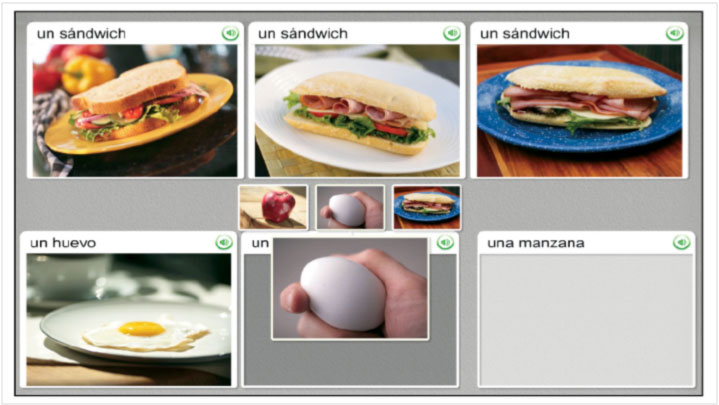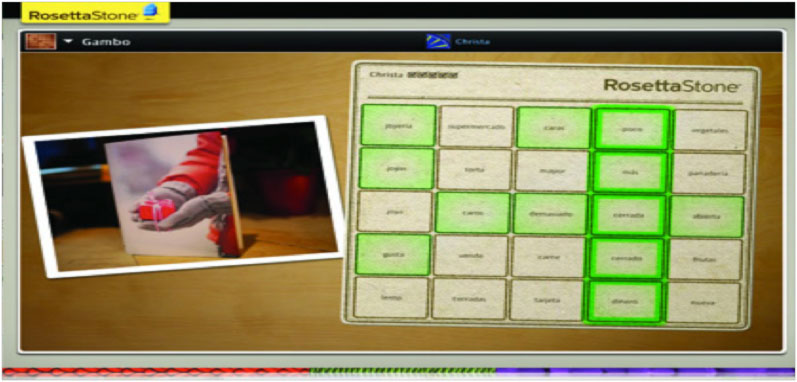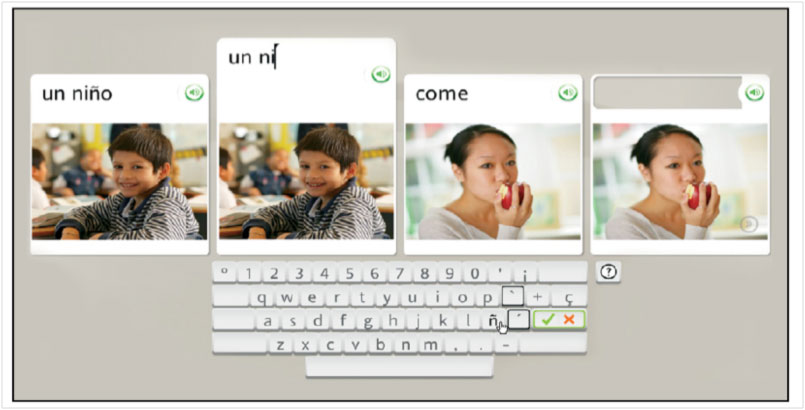June 2012 – Volume 16, Number 1
Rosetta Stone TOTALe® K-12: Spanish, Latin America
| Title | Rosetta Stone TOTALe® K-12: Spanish (Latin America) (http://www.rosettastone.com) |
| Author | Rosetta Stone Ltd. |
| Type of Product | Immersion-oriented language learning software |
| Platform | Windows XP SP3 or Vista SP1; Mac OS 10.4.9 or greater |
| Minimum System Requirements |
|
| Price | Levels 1 through 5 set US $749.00 |
Introduction and Framework
Since online communication and digital technology have become new literacies in our lives, new software has been developed to enhance learning and interaction among users (Buckleitner, 1999). Language, now more than ever, is fundamental in communicating and in interacting with others online and face to face. Therefore, it is important to evaluate new language software within a new literacies framework. “New literacies” is an evolving term that faces constant change as new technologies and strategies emerge (Cammack, Coiro, Kinzer, & Leu, 2004). New literacies is not a new concept itself, but rather it addresses constantly changing strategies, tools, and technologies involved in the process of learning and interacting with other people. To this end, the term literacy has become widely related not only to reading and writing, but also to any form of knowledge acquisition and learning. Literacy involves all the different skills and processes required to interact and understand one another. These include reading, writing, listening, speaking, using technology, understanding visuals, using numbers, and critical thinking to communicate and comprehend the world.
To evaluate the Rosetta Stone software, I will use the new literacies framework for software evaluation in school-based settings proposed by Cummins et.al (2007). Within this framework it is important to answer the following six questions:
- Does technology-supported instruction provide cognitive challenge and opportunities for deep processing of meaning?
- Does the instruction relate to prior knowledge and experiences derived from student’s homes and communities?
- Does the instruction promote active self-regulated collaborative inquiry?
- Does the instruction promote extensive engaged reading and writing across the curriculum?
- Does the instruction help students develop strategies for effective reading, writing, and learning?
- Does the instruction promote effective involvement and identity investment on the part of students?
Cummins et.al (2007) highlight that technologies should not attempt to instruct but rather to support the construction of knowledge; thus students should use these technologies to “learn with, not from” (p. 110). To evaluate this program, I will first give an overview of the program. After that, I will discuss my experiences using the program. Finally, I will evaluate the program within the framework previously mentioned.
Overview of the program
Rosetta Stone is a language-learning program developed by Rosetta Stone Ltd.. The program uses a combination of images, sound, and text presented as PowerPoint slides according to the level of the learner. The company calls the method used in their program “Dynamic Immersion,” claiming that this program is designed to teach languages in the way first languages are learned. Rosetta Stone defines immersion as images, intuition, interaction, and instruction. The learner can see the image and the text and, at the same time, listen to and repeat words or phrases.
The company offers language learning software in more than 30 languages and for different target populations. Here I will focus on Spanish Latin America TOTALe®, especially designed for grades K-12. This program, according to the company, will be launched in 2012 and has been specially designed for K-12 students, schools, and teachers.
Figure 1 shows the home page of the program. The program first checks the learner’s computer for minimum system requirements,including checks for sound and voice capability. Headphones are recommended for a better experience as well as for the program’s speech recognition system.
Figure 1. Home page Rosetta Stone Spanish (Latin America)
Figure 2 shows one of the activities where the learner listens to a phrase and chooses the corresponding picture. In this initial activity, the learner’s answer is based on trial and error. If the answer is not correct, the computer will make a sound and show an X mark telling the learner it is incorrect. If the answer is correct, the learner will receive a check mark as shown in Figure 2.

Figure 2. Activity for beginners
In the matching exercise in Figure 3, the learner is first provided with aural and visual examples and then is expected to choose the image that matches both the sound and the previously shown image.

Figure 3. Sample matching activity
In fill-in-the-blank activities, after several exposures to words and sounds, the learner is expected to choose the correct word by looking at a picture. Again, if an incorrect answer is chosen, the program will make a sound to tell the learner that the answer is incorrect (see Figure 4).

Figure 4. Sample fill-in-the-blank activity
Figure 5 provides an example of one of the games a learner can play by him/herself. In the example of a Bingo game, a voice tells a story while thelearner selects words from a given chart.. The game is over when the learner creates a bingo line (as shown in Figure 5).

Figure 5. Sample Bingo game
An example of a typing exercise is shown in figure 6; the learner is given a word or phrase, either by seeing it, hearing it, or both, and then types the text in the space provided.

Figure 6. Sample typing activity
This program also includes administrative tools that allow teachers to keep track of students’ progress, as shown in figure 7.

Figure 7. Sample learner reports for teachers
Personal Experience
The beginning of my exploration of Spanish Latin America was confusing; I did not know what to do on each activity, but after trying for a while I caught on. Voice recognition and pronunciation activities were problematic.For example, problems arose when I pronunced the word “sandwich.” Each time I pronounced the word, I received an X mark indicating an incorrect response. I should mention here that my first language is Spanish. More specifically, I am from Colombia in South America, so I was truly frustrated being judged as incorrectly pronouncing a word in my native language
Evaluation
Reviewing Rosetta Stone Spanish Latin America using the Cummins et.al (2006) framework allows us to see the strengths and the weaknesses of the program.
1. Does the program provide cognitive challenge and opportunities for deep processing of meaning?
After reviewing the program, I consider that there to be a lack of such cognitive challenges and opportunities. Although there are a variety of activities and levels, such activities do not require the learner to think critically or to have a deep understanding of the subject. As the creators mention, the activities work with the learner’s ability to infer by using his/her intuition to follow the exercises and by repetition. It is important to mention that not all learners work well this way, and some may be frustrated with the learning style. It seems that providing cognitive challenges and opportunities for deep processing of meaning, does not seem to be a strong focus of the program.
2. Does the program relate instruction to prior knowledge and experiences derived from student’s homes and communities?
The majority of the activities and games in Rosetta Stone are designed to activate the learner’s prior knowledge. For instance, after listening and seeing the word or phrase learners are expected to complete diverse activities where they have to use the vocabulary learned in previous activities and lessons. It is important to mention that such activities just fulfill the prior knowledge part. They do not relate to the learner’s prior life experiences from her/his home or community. The learner is not asked or expected to use such experiences. The program is not intended to connect with students’ experiences nor teach them using “cultural data sets” (Lee, 2007). Even if the program provided lesson plans for K-12 teachers, these lessons would only reinforce vocabulary and grammar points without necessarily making deeper connections.
3. Does the program promote active self-regulated collaborative inquiry?
Collaboration is fostered in Rosetta Stone through online games, activities, and practice with tutors, but the program is limited in terms of collaborative inquiry. These activities are just intended to provide practice of the second language vocabulary and do not require students to investigate topics further, share ideas, or make appropriate use of technology. Students are not expected to share or create any product collaboratively.
4. Does the program promote extensive engaged reading and writing across the curriculum?
Certainly the promotion of engaged reading and writing across the curriculum is the weakest part of the program. Even if reading and writing are implicit in the program’s design, students are not required to extensively engage in these activities. Although the program is designed specifically for K-12, it is not tied to any content area, nor is it intended to further develop students’ abilities to read and write. As previously shown in the screen shots, students are expected to read and write sentences, but not extensively.
5. Does the program help students develop strategies for effective reading, writing, and learning?
Effective reading and writing strategies are not part of Rosetta Stone’s software. The main focus of the program is listening and comprehension; reading and writing are included only incidentally. For example, students are not asked to write compositions or essays. Supplemental materials for K-12 classrooms reinforce the language by practice and repetition, but are not related to developing such strategies in a more advanced manner.
6. Does the program promote effective involvement and identity investment on the part of students?
Students have plenty of opportunities to interact with other students as well as with instructors online, which helps them to be enthusiastic about learning. Identity is also promoted as students participate in diverse activities. This is one of the strongest parts of the program. Although such opportunities are also promoted, they are limited to some extent. The games are basic and one gets bored after playing the same games for a while. More opportunities should be provided for students to interact online with instructors and/or other students.
Conclusion
All in all, Rosetta Stone Spanish Latin America is an interesting language program that has some strengths as well as weaknesses. Some of the strengths are related to providing opportunities for students to interact, practice the language, learn from others, and use previous knowledge to build on vocabulary. On the other hand, it is important to mention that Rosetta Stone does not foster critical thinking skills nor deeper connections and collaboration among learners. Lastly, activities that develop strategies for effective reading, writing, and learning are not provided. I believe this program has much room for improvement. It is important for potential users to consider how it could be adapted to better fit 21st century technologies and classrooms where deeper connections and critical thinking are promoted.
Note: all the pictures shown and used here are property of Rosetta Stone Ltd, and have been downloaded with the company’s permission for the purpose of this review.
References
Buckleitner, W. (1999). The state of children’s software evaluation: Yesterday, today, and in the 21st century. Retrieved April 28, 2011 from: http://www.childrenssoftware.com/evaluation.html
Cummins, J., Brown, K., & Sayers, D. (2007). Literacy, technology, and diversity: Teaching for success in changing times. Boston: Allyn & Bacon/Pearson.
Lankshear, C., & Knobel, M. (2006). New literacies: Everyday practices and classroom learning. London: Open University Press.
Lee, C. D. (2007). Culture, literacy, and learning: Taking bloom in the midst of the whirlwind. New York: Teacher’s College Press.
Leu, D.J., Jr., Kinzer, C.K., Coiro, J., & Cammack, D.W (2004). Toward a theory of new literacies emerging from the internet and other information and communication technologies. Retrieved on April, 28, 2011 from http://www.readingonline.org/newliteracies/leu/
About the Reviewer
Sonia Isabel Lopez-Lopez is a full time Spanish instructor at the Department of Foreign Languages at Washington State University. She is currently a doctoral student in the Language Literacy and Technology program at the same university. Lopez-Lopez holds a Masters in Foreign Languages and a Masters in Teaching. She has more than ten years of experience teaching classes at the elementary, middle, and high school, and university level in both English and Spanish. Her research interests include Bilingual Education and Policy and Second Language Teaching and Learning.
<silopez-lopez wsu.edu>
wsu.edu>
| © Copyright rests with authors. Please cite TESL-EJ appropriately. |


